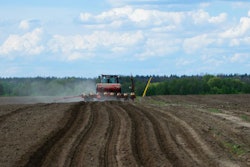
Rabobank’s newest agribusiness review for the region shows factors pressuring ag markets.
Higher prices and smaller planted area will continue to affect the North American animal feed market, according to Rabobank’s latest North American Agribusiness Review for April.
Drought conditions continue, with the Southern Plains seeing severe or extreme drought. If drought conditions continue, it will pressure an already tight feed grain and hay market, the report said.
With the war in Ukraine upending the global grain supply and trade, the world will turn to Brazil and the U.S for corn and prices will rise.
“It is an understatement to say the commodity world was turned upside down on February 24, but corn is squarely in the middle of the bullish commodity reaction,” Rabobank said in the report.
And while the world needs more corn, the U.S. will plant 4.2 million fewer acres in 2022 than in 2021. This means a tight balance sheet for corn and fewer options for animal feed operations to substitute corn in feed rations.
Feed prices are expected to remain high and could go even higher, with volatility expected to continue over the summer.
“The June report on final planted acres and crop development will become key in price discovery and setting the stage for marketing year 2022-23,” the report said.
Poultry
Composite chicken prices are 66% higher than a year ago, and retail and foodservice are seeing good demand.
Supply could be reduced in the wake of avian influenza (AI) outbreaks, but Rabobank said there has been almost no material commercial loss of broilers to AI as of mid-April.
“However, the threat of losing export market access in the event HPAI is confirmed in a key production state remains a significant risk,” the report said.
Production of ready-to-cook chicken in the first quarter is up 1.6% from the previous year.
The increase in the hatchery supply flock from the second half of 2021 is expected to boost broiler production in the first half of this year, although high feed costs and AI could affect this.
Record chicken exports continue, with February volumes up 18% and total value up 32% year over year.
In Mexico, demand for chicken continues to outpace supplies.
Pork
Hog production is expected to be lower than a year ago due to herd contraction and higher mortality levels; U.S. slaughter is down 6.2% year to date through April, “but will more closely mirror 2021 volumes as availability narrows over the balance of the year.”
U.S. hog slaughter is forecast to decline 2.4% year over year. Meanwhile, pork values are down slightly from a year ago but 30% higher than the five-year average.
Pork trade is expected to benefit from the AI situation, but global markets are expected to remain competitive, Rabobank said.
Wheat
The war in Ukraine has had a massive effect on global wheat markets, and the world’s major wheat exporters likely do not have sufficient stocks to fill in the gap left by Ukraine and Russia, Rabobank said.
“The near stoppage of wheat shipments out of the Black Sea region are fueling growing concerns about food security, particularly in northern Africa, Middle East and sub-Saharan Africa due to declining shipments and fast increasing prices,” the report said.
The U.S. is likely to see increased wheat exports as a result of the war, and U.S. hard red wheat is experiencing drought and extreme weather.
Soybeans
Soybeans are becoming the dominant crop in North America, with the soybean planted area expected to grow 4% to a record high number of acres. Lower soybean production in South America is driving demand for U.S. soybean exports.
The war in Ukraine, lower soybean production and weather concerns will continue to support prices.
Labor and inflation
Labor is a major wild card in the shipping sector, with more than 22,000 unionized workers at 29 ports on the West Coast scheduled to begin contract negotiations on May 12.
“The contract negotiation happens every six years and caused severe disruptions and delays in shipping during the last cycle. This year, amid a tight labor market, congested ports and historical consumer demand, a lot is at stake,”
Inflation from food at home was 10% in March, while for food away from home, it was 6.9%. Higher food prices are causing consumers to switch to discount brands and sale shopping.













